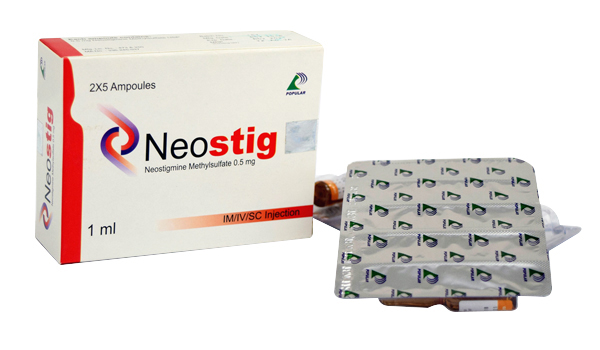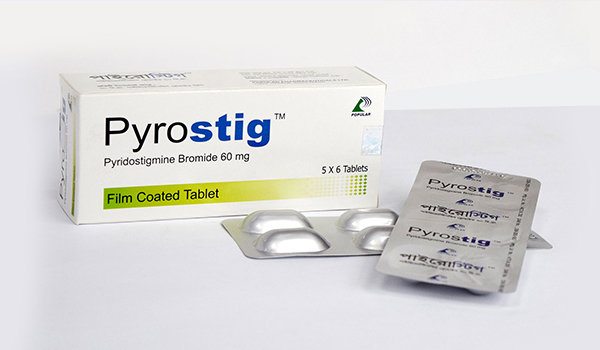Indication
Neostig is indicated for:
(1) The symptomatic control of myasthenia gravis when oral therapy is impractical.
(2) The prevention and treatment of postoperative distention and urinary retention after mechanical obstruction has been excluded.
(3) Reversal of effects of nondepolarizing neuromuscular blocking agents (e.g., Tubocurarine, metocurine, gallamine or pancuronium) after surgery.
Dosage & Administration
Antagonist to Nondepolarising Neuromuscular Blockade:
Adults: A single dose of Neostigmine Methylsulfate injection 2 to 3 mg with atropine sulphate 0.6-1.2 mg by slow IV injection over 1 minute. The recommended ratio of atropine to Neostigmine Methylsulfate injection is 1:2 to 1:3. The maximum recommended dose of Neostigmine Methylsulfate injection in adults is 5 mg.
Children: The suggested dose in children is 0.05 mg/kg/dose and atropine sulphate 0.02 mg/kg/dose by slow IV injection. Maximum recommended dose of Neostigmine Methylsulfate injection in children is 2.5 mg.
Myasthenia Gravis:
Adults: 1 mg to 2.5 mg given IM or SC at intervals throughout the day when greater strength may be needed (e.g. mornings and before meals), given a total daily dose of 5 to 20 mg. Duration of action of a single dose is 2 to 4 hours.
Neonates: 0.05-0.25 mg IM every 2-4 hours, half an hour before feeding. Treatment is not usually required beyond 8 weeks of age. Because the condition is usually self limiting the daily dosage should gradually be reduced until the medicine can be withdrawn. When large doses of Neostigmine Methylsulfate injection are given to myasthenic patients, atropine sulphate may be required to counteract the muscarinic side effects.
Urinary Retention:
Prophylaxis: 0.25 mg SC or IM before or immediately after the operation, repeated every 4 to 6 hours for 2-3 days.
Treatment: 0.5 mg SC or IM and apply warmth to lower abdomen. After patient has voided continue 0.5 mg SC or IM every 3 hours for at least 5 injections. If there has been no urinary response within one hour of the first dose, the patient should be catheterised.
Precautions
Neostigmine Methylsulfate should be used with caution in patients with epilepsy, bronchial asthma, bradycardia, recent coronary occlusion, vagotonia, hyperthyroidism, cardiac arrhythmias or peptic ulcer. When large doses of Neostigmine Methylsulfate are administered, the prior or simultaneous injection of atropine sulfate may be advisable. Separate syringes should be used for the Neostigmine Methylsulfate and atropine. Because of the possibility of hypersensitivity in an occasional patient, atropine and antishock medication should always be readily available.
Use in Pregnancy: Pregnancy Category C -There are no adequate or well-controlled studies of Neostigmine Methylsulfate in either laboratory animals or in pregnant women. It is not known whether Neostigmine Methylsulfate can cause fetal harm when administered to a pregnant woman or can affect reproductive capacity. Neostigmine Methylsulfate should be given to a pregnant woman only if clearly needed.
Nonteratogenic Effects: Anticholinesterase drugs may cause uterine irritability and induce premature labor when given IV to pregnant women near term.
Use in Lactation: It is not known whether Neostigmine Methylsulfate is excreted in human milk. Because many drugs are excreted in human milk and because of the potential for serious adverse reactions from Neostigmine Methylsulfate in nursing infants, a decision should be made whether to discontinue nursing onto discontinue the drug, taking into account the importance of the drug to the mother.


